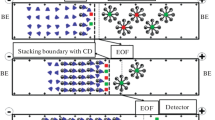Abstract
Accurate knowledge of the electroosmotic flow mobility is crucial for the determination of effective electrophoretic mobilities in capillary electrophoresis. The addition of a neutral marker to the sample is a common method for electroosmotic flow mobility measurement. Nevertheless, the neutral marker can also exhibit electrophoretic mobility due to its interactions with background electrolyte constituents. In our previous study, we have shown the effect of different cations in background electrolytes with a fixed anion. In this work, the relative mobility of neutral compounds, either those commonly used as electroosmotic flow markers or their structurally related molecules, was measured in the presence of various anions in the background electrolyte with sodium as a fixed cation at pH 4.5. The mobility of eight compounds, formamide, N-methylformamide, N,N-dimethylformamide, acrylamide, N,N-dimethylacrylamide, N-methylacetamide, mesityl oxide, and dimethyl sulfoxide, was related to the mobility of thiourea. The studied anions were chloride, perchlorate, sulfate, and acetate. The results revealed a dramatic effect of perchlorate. The interaction with perchlorate strengthens significantly with the increasing number of non-polar moieties, such as methyl or acryl, present in the marker molecule. On the other hand, sulfate showed a very weak effect on all the studied compounds.
Graphic abstract



Similar content being viewed by others
References
Štěpánová S, Kašička V (2015) J Sep Sci 38:2708
Ušelová-Včeláková K, Zusková I, Gaš B (2007) Electrophoresis 28:2145
Lauer HH, McManigill D (1986) Anal Chem 58:166
Huang X, Gordon MJ, Zare RN (1988) Anal Chem 60:1837
Altria KD, Simpson CF (1987) Chromatographia 24:527
Stevens TS, Cortes HJ (1983) Anal Chem 55:1365
Kuhr WG, Licklider L, Amankwa L (1993) Anal Chem 65:277
Lee TT, Dadoo R, Zare RN (1994) Anal Chem 66:2694
Ehala S, Dybal J, Makrlík E, Kašička V (2009) J Sep Sci 32:597
Ehala S, Toman P, Rathore R, Makrlík E, Kašička V (2011) Electrophoresis 32:981
Chatterjee SK, Prokopová E, Bohdanecký M (1987) Eur Polym J 14:665
Müllerová L, Dubský P, Svobodová J, Gaš B (2013) Electrophoresis 34:768
Křížek T, Kubíčková A, Hladílková J, Coufal P, Heyda J, Jungwirth P (2014) Electrophoresis 35:617
Martínková E, Křížek T, Kubíčková A, Coufal P (2021) Electrophoresis 42:932
Kunz W, Henle J, Ninham BW (2004) Curr Opin Colloid Interface Sci 9:19
Acknowledgements
This work has been supported by Charles University, project SVV 260560.
Author information
Authors and Affiliations
Corresponding author
Additional information
Publisher's Note
Springer Nature remains neutral with regard to jurisdictional claims in published maps and institutional affiliations.
Rights and permissions
About this article
Cite this article
Čokrtová, K., Křížek, T., Kubíčková, A. et al. Effect of background electrolyte anions on markers of electroosmotic flow in capillary electrophoresis. Monatsh Chem 152, 1061–1065 (2021). https://doi.org/10.1007/s00706-021-02810-x
Received:
Accepted:
Published:
Issue Date:
DOI: https://doi.org/10.1007/s00706-021-02810-x



